Systematic Review and Meta-Analysis of FDG, NaF PET, and Tc 99 MDP Tracers in Evaluation of Bone Metastasis of Neuroblastoma in Paediatric
VerifiedAdded on 2022/11/24
|13
|3735
|457
AI Summary
This paper focuses on the systematic review and meta-analysis of the benefits of comparison of FDG, NaF PET, and Tc 99 MDP tracers in the evaluation of the bone metastasis of neuroblastoma in paediatric, allowing early detection and prevention of the progression right on time.
Contribute Materials
Your contribution can guide someone’s learning journey. Share your
documents today.

Project
Secure Best Marks with AI Grader
Need help grading? Try our AI Grader for instant feedback on your assignments.
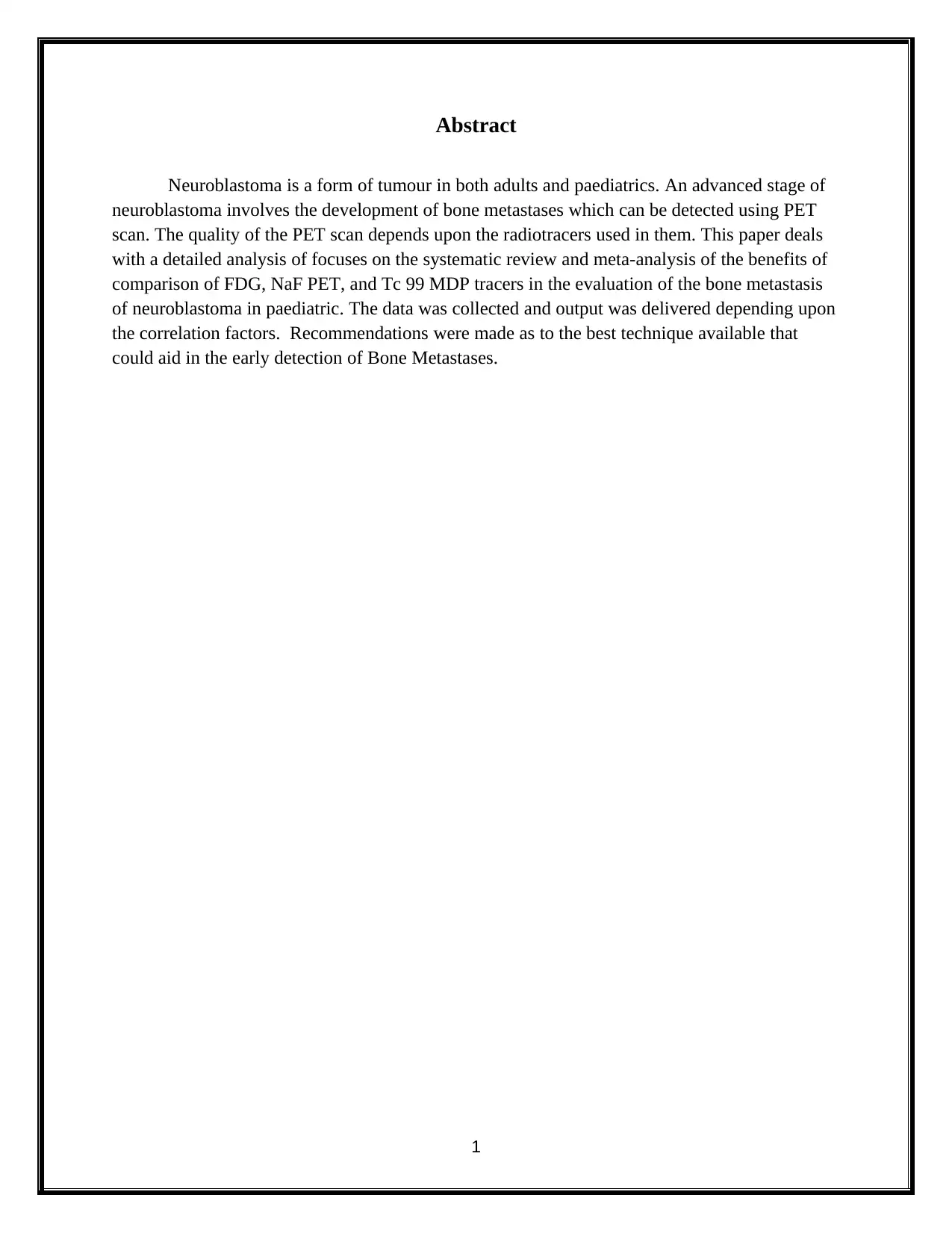
Abstract
Neuroblastoma is a form of tumour in both adults and paediatrics. An advanced stage of
neuroblastoma involves the development of bone metastases which can be detected using PET
scan. The quality of the PET scan depends upon the radiotracers used in them. This paper deals
with a detailed analysis of focuses on the systematic review and meta-analysis of the benefits of
comparison of FDG, NaF PET, and Tc 99 MDP tracers in the evaluation of the bone metastasis
of neuroblastoma in paediatric. The data was collected and output was delivered depending upon
the correlation factors. Recommendations were made as to the best technique available that
could aid in the early detection of Bone Metastases.
1
Neuroblastoma is a form of tumour in both adults and paediatrics. An advanced stage of
neuroblastoma involves the development of bone metastases which can be detected using PET
scan. The quality of the PET scan depends upon the radiotracers used in them. This paper deals
with a detailed analysis of focuses on the systematic review and meta-analysis of the benefits of
comparison of FDG, NaF PET, and Tc 99 MDP tracers in the evaluation of the bone metastasis
of neuroblastoma in paediatric. The data was collected and output was delivered depending upon
the correlation factors. Recommendations were made as to the best technique available that
could aid in the early detection of Bone Metastases.
1

Table of Contents
Introduction................................................................................................................................. 3
Statistical analysis........................................................................................................................ 3
Discussion about the Statistical Analysis........................................................................................4
FDG PET scan............................................................................................................................. 4
F-NaF PET................................................................................................................................... 5
Tc 99 MDP................................................................................................................................... 5
Future scope of the study..............................................................................................................6
Limitations................................................................................................................................... 7
Implications of the study...............................................................................................................8
Conclusion................................................................................................................................... 9
Bibliography.............................................................................................................................. 11
2
Introduction................................................................................................................................. 3
Statistical analysis........................................................................................................................ 3
Discussion about the Statistical Analysis........................................................................................4
FDG PET scan............................................................................................................................. 4
F-NaF PET................................................................................................................................... 5
Tc 99 MDP................................................................................................................................... 5
Future scope of the study..............................................................................................................6
Limitations................................................................................................................................... 7
Implications of the study...............................................................................................................8
Conclusion................................................................................................................................... 9
Bibliography.............................................................................................................................. 11
2
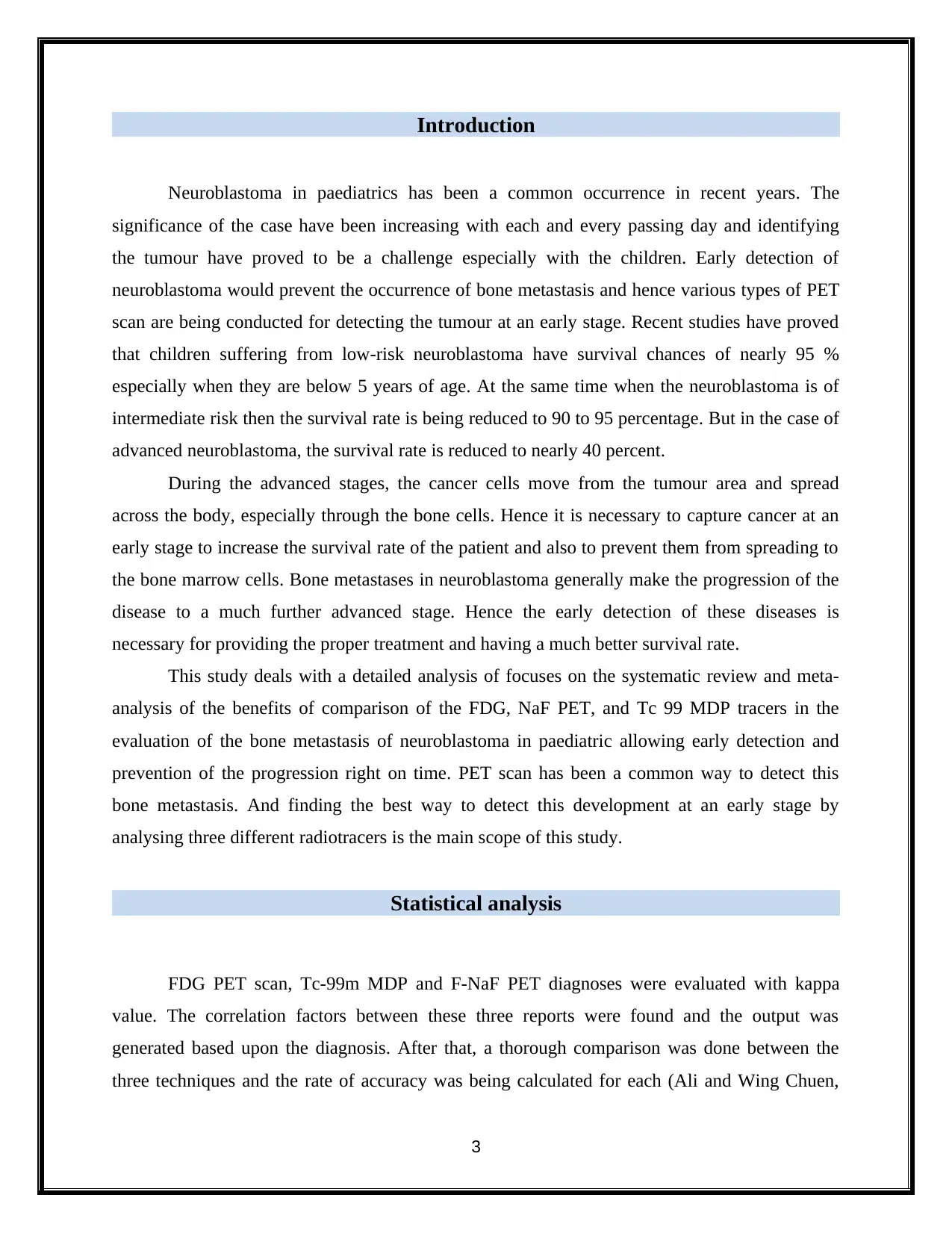
Introduction
Neuroblastoma in paediatrics has been a common occurrence in recent years. The
significance of the case have been increasing with each and every passing day and identifying
the tumour have proved to be a challenge especially with the children. Early detection of
neuroblastoma would prevent the occurrence of bone metastasis and hence various types of PET
scan are being conducted for detecting the tumour at an early stage. Recent studies have proved
that children suffering from low-risk neuroblastoma have survival chances of nearly 95 %
especially when they are below 5 years of age. At the same time when the neuroblastoma is of
intermediate risk then the survival rate is being reduced to 90 to 95 percentage. But in the case of
advanced neuroblastoma, the survival rate is reduced to nearly 40 percent.
During the advanced stages, the cancer cells move from the tumour area and spread
across the body, especially through the bone cells. Hence it is necessary to capture cancer at an
early stage to increase the survival rate of the patient and also to prevent them from spreading to
the bone marrow cells. Bone metastases in neuroblastoma generally make the progression of the
disease to a much further advanced stage. Hence the early detection of these diseases is
necessary for providing the proper treatment and having a much better survival rate.
This study deals with a detailed analysis of focuses on the systematic review and meta-
analysis of the benefits of comparison of the FDG, NaF PET, and Tc 99 MDP tracers in the
evaluation of the bone metastasis of neuroblastoma in paediatric allowing early detection and
prevention of the progression right on time. PET scan has been a common way to detect this
bone metastasis. And finding the best way to detect this development at an early stage by
analysing three different radiotracers is the main scope of this study.
Statistical analysis
FDG PET scan, Tc-99m MDP and F-NaF PET diagnoses were evaluated with kappa
value. The correlation factors between these three reports were found and the output was
generated based upon the diagnosis. After that, a thorough comparison was done between the
three techniques and the rate of accuracy was being calculated for each (Ali and Wing Chuen,
3
Neuroblastoma in paediatrics has been a common occurrence in recent years. The
significance of the case have been increasing with each and every passing day and identifying
the tumour have proved to be a challenge especially with the children. Early detection of
neuroblastoma would prevent the occurrence of bone metastasis and hence various types of PET
scan are being conducted for detecting the tumour at an early stage. Recent studies have proved
that children suffering from low-risk neuroblastoma have survival chances of nearly 95 %
especially when they are below 5 years of age. At the same time when the neuroblastoma is of
intermediate risk then the survival rate is being reduced to 90 to 95 percentage. But in the case of
advanced neuroblastoma, the survival rate is reduced to nearly 40 percent.
During the advanced stages, the cancer cells move from the tumour area and spread
across the body, especially through the bone cells. Hence it is necessary to capture cancer at an
early stage to increase the survival rate of the patient and also to prevent them from spreading to
the bone marrow cells. Bone metastases in neuroblastoma generally make the progression of the
disease to a much further advanced stage. Hence the early detection of these diseases is
necessary for providing the proper treatment and having a much better survival rate.
This study deals with a detailed analysis of focuses on the systematic review and meta-
analysis of the benefits of comparison of the FDG, NaF PET, and Tc 99 MDP tracers in the
evaluation of the bone metastasis of neuroblastoma in paediatric allowing early detection and
prevention of the progression right on time. PET scan has been a common way to detect this
bone metastasis. And finding the best way to detect this development at an early stage by
analysing three different radiotracers is the main scope of this study.
Statistical analysis
FDG PET scan, Tc-99m MDP and F-NaF PET diagnoses were evaluated with kappa
value. The correlation factors between these three reports were found and the output was
generated based upon the diagnosis. After that, a thorough comparison was done between the
three techniques and the rate of accuracy was being calculated for each (Ali and Wing Chuen,
3
Secure Best Marks with AI Grader
Need help grading? Try our AI Grader for instant feedback on your assignments.
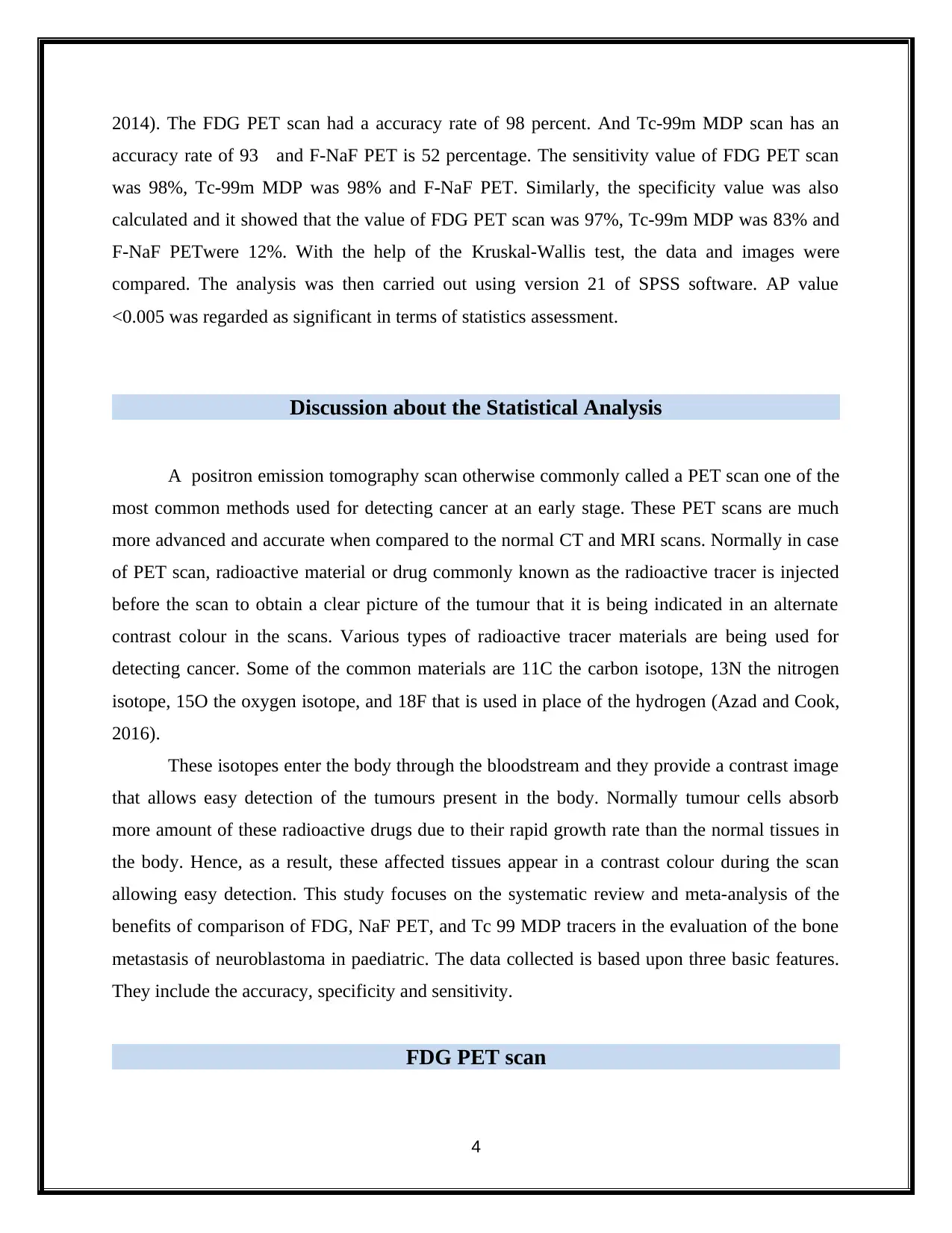
2014). The FDG PET scan had a accuracy rate of 98 percent. And Tc-99m MDP scan has an
accuracy rate of 93 and F-NaF PET is 52 percentage. The sensitivity value of FDG PET scan
was 98%, Tc-99m MDP was 98% and F-NaF PET. Similarly, the specificity value was also
calculated and it showed that the value of FDG PET scan was 97%, Tc-99m MDP was 83% and
F-NaF PETwere 12%. With the help of the Kruskal-Wallis test, the data and images were
compared. The analysis was then carried out using version 21 of SPSS software. AP value
<0.005 was regarded as significant in terms of statistics assessment.
Discussion about the Statistical Analysis
A positron emission tomography scan otherwise commonly called a PET scan one of the
most common methods used for detecting cancer at an early stage. These PET scans are much
more advanced and accurate when compared to the normal CT and MRI scans. Normally in case
of PET scan, radioactive material or drug commonly known as the radioactive tracer is injected
before the scan to obtain a clear picture of the tumour that it is being indicated in an alternate
contrast colour in the scans. Various types of radioactive tracer materials are being used for
detecting cancer. Some of the common materials are 11C the carbon isotope, 13N the nitrogen
isotope, 15O the oxygen isotope, and 18F that is used in place of the hydrogen (Azad and Cook,
2016).
These isotopes enter the body through the bloodstream and they provide a contrast image
that allows easy detection of the tumours present in the body. Normally tumour cells absorb
more amount of these radioactive drugs due to their rapid growth rate than the normal tissues in
the body. Hence, as a result, these affected tissues appear in a contrast colour during the scan
allowing easy detection. This study focuses on the systematic review and meta-analysis of the
benefits of comparison of FDG, NaF PET, and Tc 99 MDP tracers in the evaluation of the bone
metastasis of neuroblastoma in paediatric. The data collected is based upon three basic features.
They include the accuracy, specificity and sensitivity.
FDG PET scan
4
accuracy rate of 93 and F-NaF PET is 52 percentage. The sensitivity value of FDG PET scan
was 98%, Tc-99m MDP was 98% and F-NaF PET. Similarly, the specificity value was also
calculated and it showed that the value of FDG PET scan was 97%, Tc-99m MDP was 83% and
F-NaF PETwere 12%. With the help of the Kruskal-Wallis test, the data and images were
compared. The analysis was then carried out using version 21 of SPSS software. AP value
<0.005 was regarded as significant in terms of statistics assessment.
Discussion about the Statistical Analysis
A positron emission tomography scan otherwise commonly called a PET scan one of the
most common methods used for detecting cancer at an early stage. These PET scans are much
more advanced and accurate when compared to the normal CT and MRI scans. Normally in case
of PET scan, radioactive material or drug commonly known as the radioactive tracer is injected
before the scan to obtain a clear picture of the tumour that it is being indicated in an alternate
contrast colour in the scans. Various types of radioactive tracer materials are being used for
detecting cancer. Some of the common materials are 11C the carbon isotope, 13N the nitrogen
isotope, 15O the oxygen isotope, and 18F that is used in place of the hydrogen (Azad and Cook,
2016).
These isotopes enter the body through the bloodstream and they provide a contrast image
that allows easy detection of the tumours present in the body. Normally tumour cells absorb
more amount of these radioactive drugs due to their rapid growth rate than the normal tissues in
the body. Hence, as a result, these affected tissues appear in a contrast colour during the scan
allowing easy detection. This study focuses on the systematic review and meta-analysis of the
benefits of comparison of FDG, NaF PET, and Tc 99 MDP tracers in the evaluation of the bone
metastasis of neuroblastoma in paediatric. The data collected is based upon three basic features.
They include the accuracy, specificity and sensitivity.
FDG PET scan
4
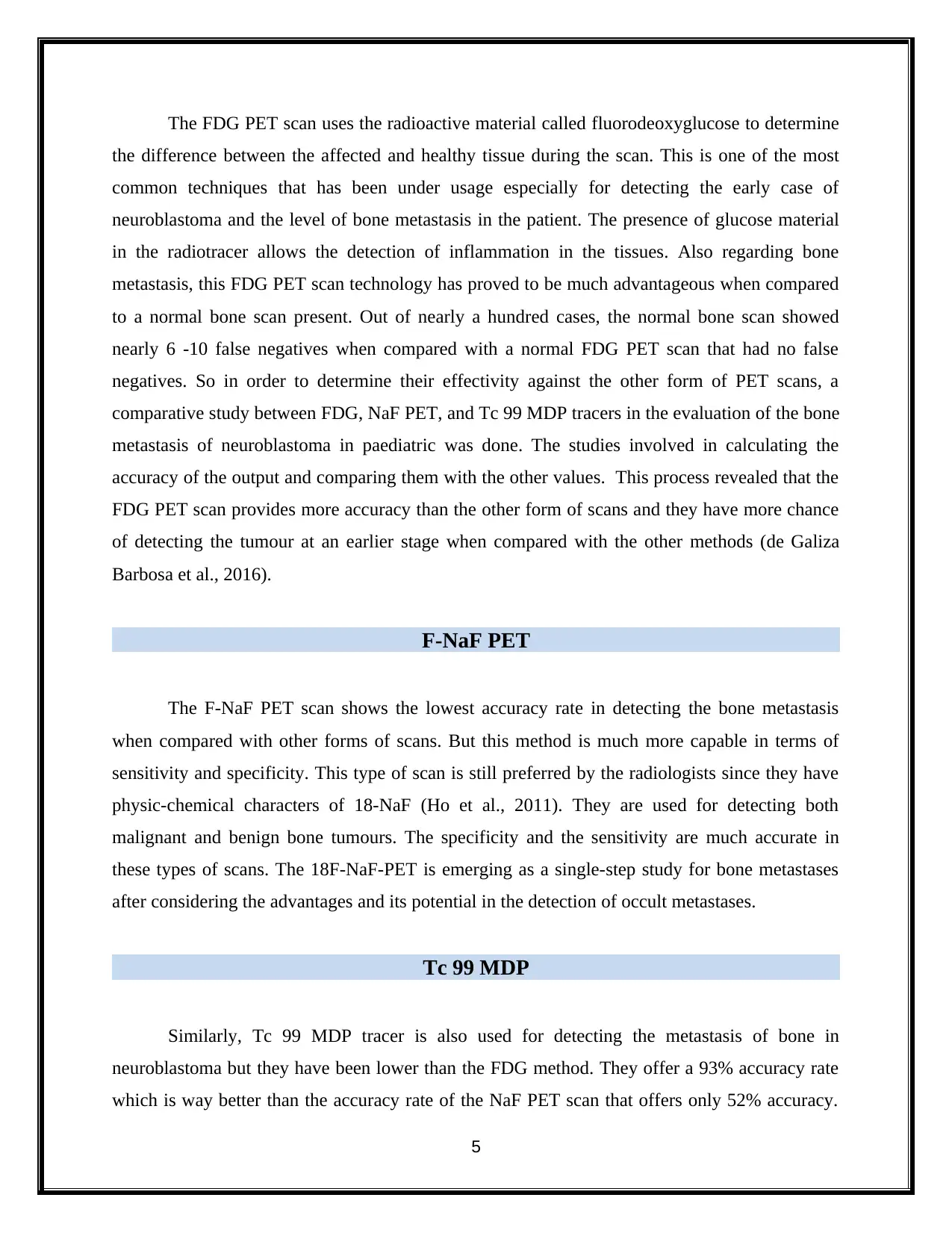
The FDG PET scan uses the radioactive material called fluorodeoxyglucose to determine
the difference between the affected and healthy tissue during the scan. This is one of the most
common techniques that has been under usage especially for detecting the early case of
neuroblastoma and the level of bone metastasis in the patient. The presence of glucose material
in the radiotracer allows the detection of inflammation in the tissues. Also regarding bone
metastasis, this FDG PET scan technology has proved to be much advantageous when compared
to a normal bone scan present. Out of nearly a hundred cases, the normal bone scan showed
nearly 6 -10 false negatives when compared with a normal FDG PET scan that had no false
negatives. So in order to determine their effectivity against the other form of PET scans, a
comparative study between FDG, NaF PET, and Tc 99 MDP tracers in the evaluation of the bone
metastasis of neuroblastoma in paediatric was done. The studies involved in calculating the
accuracy of the output and comparing them with the other values. This process revealed that the
FDG PET scan provides more accuracy than the other form of scans and they have more chance
of detecting the tumour at an earlier stage when compared with the other methods (de Galiza
Barbosa et al., 2016).
F-NaF PET
The F-NaF PET scan shows the lowest accuracy rate in detecting the bone metastasis
when compared with other forms of scans. But this method is much more capable in terms of
sensitivity and specificity. This type of scan is still preferred by the radiologists since they have
physic-chemical characters of 18-NaF (Ho et al., 2011). They are used for detecting both
malignant and benign bone tumours. The specificity and the sensitivity are much accurate in
these types of scans. The 18F-NaF-PET is emerging as a single-step study for bone metastases
after considering the advantages and its potential in the detection of occult metastases.
Tc 99 MDP
Similarly, Tc 99 MDP tracer is also used for detecting the metastasis of bone in
neuroblastoma but they have been lower than the FDG method. They offer a 93% accuracy rate
which is way better than the accuracy rate of the NaF PET scan that offers only 52% accuracy.
5
the difference between the affected and healthy tissue during the scan. This is one of the most
common techniques that has been under usage especially for detecting the early case of
neuroblastoma and the level of bone metastasis in the patient. The presence of glucose material
in the radiotracer allows the detection of inflammation in the tissues. Also regarding bone
metastasis, this FDG PET scan technology has proved to be much advantageous when compared
to a normal bone scan present. Out of nearly a hundred cases, the normal bone scan showed
nearly 6 -10 false negatives when compared with a normal FDG PET scan that had no false
negatives. So in order to determine their effectivity against the other form of PET scans, a
comparative study between FDG, NaF PET, and Tc 99 MDP tracers in the evaluation of the bone
metastasis of neuroblastoma in paediatric was done. The studies involved in calculating the
accuracy of the output and comparing them with the other values. This process revealed that the
FDG PET scan provides more accuracy than the other form of scans and they have more chance
of detecting the tumour at an earlier stage when compared with the other methods (de Galiza
Barbosa et al., 2016).
F-NaF PET
The F-NaF PET scan shows the lowest accuracy rate in detecting the bone metastasis
when compared with other forms of scans. But this method is much more capable in terms of
sensitivity and specificity. This type of scan is still preferred by the radiologists since they have
physic-chemical characters of 18-NaF (Ho et al., 2011). They are used for detecting both
malignant and benign bone tumours. The specificity and the sensitivity are much accurate in
these types of scans. The 18F-NaF-PET is emerging as a single-step study for bone metastases
after considering the advantages and its potential in the detection of occult metastases.
Tc 99 MDP
Similarly, Tc 99 MDP tracer is also used for detecting the metastasis of bone in
neuroblastoma but they have been lower than the FDG method. They offer a 93% accuracy rate
which is way better than the accuracy rate of the NaF PET scan that offers only 52% accuracy.
5
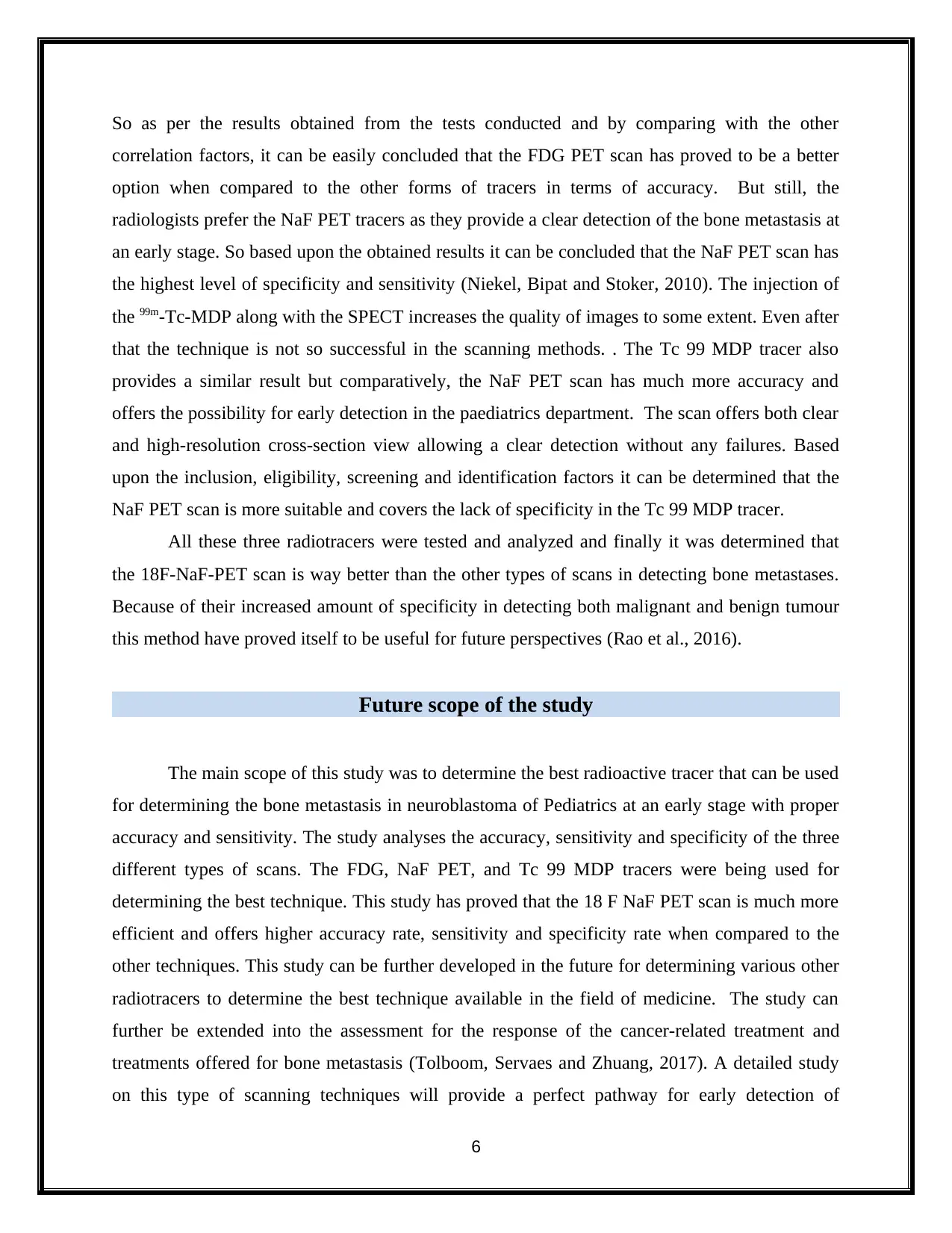
So as per the results obtained from the tests conducted and by comparing with the other
correlation factors, it can be easily concluded that the FDG PET scan has proved to be a better
option when compared to the other forms of tracers in terms of accuracy. But still, the
radiologists prefer the NaF PET tracers as they provide a clear detection of the bone metastasis at
an early stage. So based upon the obtained results it can be concluded that the NaF PET scan has
the highest level of specificity and sensitivity (Niekel, Bipat and Stoker, 2010). The injection of
the 99m-Tc-MDP along with the SPECT increases the quality of images to some extent. Even after
that the technique is not so successful in the scanning methods. . The Tc 99 MDP tracer also
provides a similar result but comparatively, the NaF PET scan has much more accuracy and
offers the possibility for early detection in the paediatrics department. The scan offers both clear
and high-resolution cross-section view allowing a clear detection without any failures. Based
upon the inclusion, eligibility, screening and identification factors it can be determined that the
NaF PET scan is more suitable and covers the lack of specificity in the Tc 99 MDP tracer.
All these three radiotracers were tested and analyzed and finally it was determined that
the 18F-NaF-PET scan is way better than the other types of scans in detecting bone metastases.
Because of their increased amount of specificity in detecting both malignant and benign tumour
this method have proved itself to be useful for future perspectives (Rao et al., 2016).
Future scope of the study
The main scope of this study was to determine the best radioactive tracer that can be used
for determining the bone metastasis in neuroblastoma of Pediatrics at an early stage with proper
accuracy and sensitivity. The study analyses the accuracy, sensitivity and specificity of the three
different types of scans. The FDG, NaF PET, and Tc 99 MDP tracers were being used for
determining the best technique. This study has proved that the 18 F NaF PET scan is much more
efficient and offers higher accuracy rate, sensitivity and specificity rate when compared to the
other techniques. This study can be further developed in the future for determining various other
radiotracers to determine the best technique available in the field of medicine. The study can
further be extended into the assessment for the response of the cancer-related treatment and
treatments offered for bone metastasis (Tolboom, Servaes and Zhuang, 2017). A detailed study
on this type of scanning techniques will provide a perfect pathway for early detection of
6
correlation factors, it can be easily concluded that the FDG PET scan has proved to be a better
option when compared to the other forms of tracers in terms of accuracy. But still, the
radiologists prefer the NaF PET tracers as they provide a clear detection of the bone metastasis at
an early stage. So based upon the obtained results it can be concluded that the NaF PET scan has
the highest level of specificity and sensitivity (Niekel, Bipat and Stoker, 2010). The injection of
the 99m-Tc-MDP along with the SPECT increases the quality of images to some extent. Even after
that the technique is not so successful in the scanning methods. . The Tc 99 MDP tracer also
provides a similar result but comparatively, the NaF PET scan has much more accuracy and
offers the possibility for early detection in the paediatrics department. The scan offers both clear
and high-resolution cross-section view allowing a clear detection without any failures. Based
upon the inclusion, eligibility, screening and identification factors it can be determined that the
NaF PET scan is more suitable and covers the lack of specificity in the Tc 99 MDP tracer.
All these three radiotracers were tested and analyzed and finally it was determined that
the 18F-NaF-PET scan is way better than the other types of scans in detecting bone metastases.
Because of their increased amount of specificity in detecting both malignant and benign tumour
this method have proved itself to be useful for future perspectives (Rao et al., 2016).
Future scope of the study
The main scope of this study was to determine the best radioactive tracer that can be used
for determining the bone metastasis in neuroblastoma of Pediatrics at an early stage with proper
accuracy and sensitivity. The study analyses the accuracy, sensitivity and specificity of the three
different types of scans. The FDG, NaF PET, and Tc 99 MDP tracers were being used for
determining the best technique. This study has proved that the 18 F NaF PET scan is much more
efficient and offers higher accuracy rate, sensitivity and specificity rate when compared to the
other techniques. This study can be further developed in the future for determining various other
radiotracers to determine the best technique available in the field of medicine. The study can
further be extended into the assessment for the response of the cancer-related treatment and
treatments offered for bone metastasis (Tolboom, Servaes and Zhuang, 2017). A detailed study
on this type of scanning techniques will provide a perfect pathway for early detection of
6
Paraphrase This Document
Need a fresh take? Get an instant paraphrase of this document with our AI Paraphraser
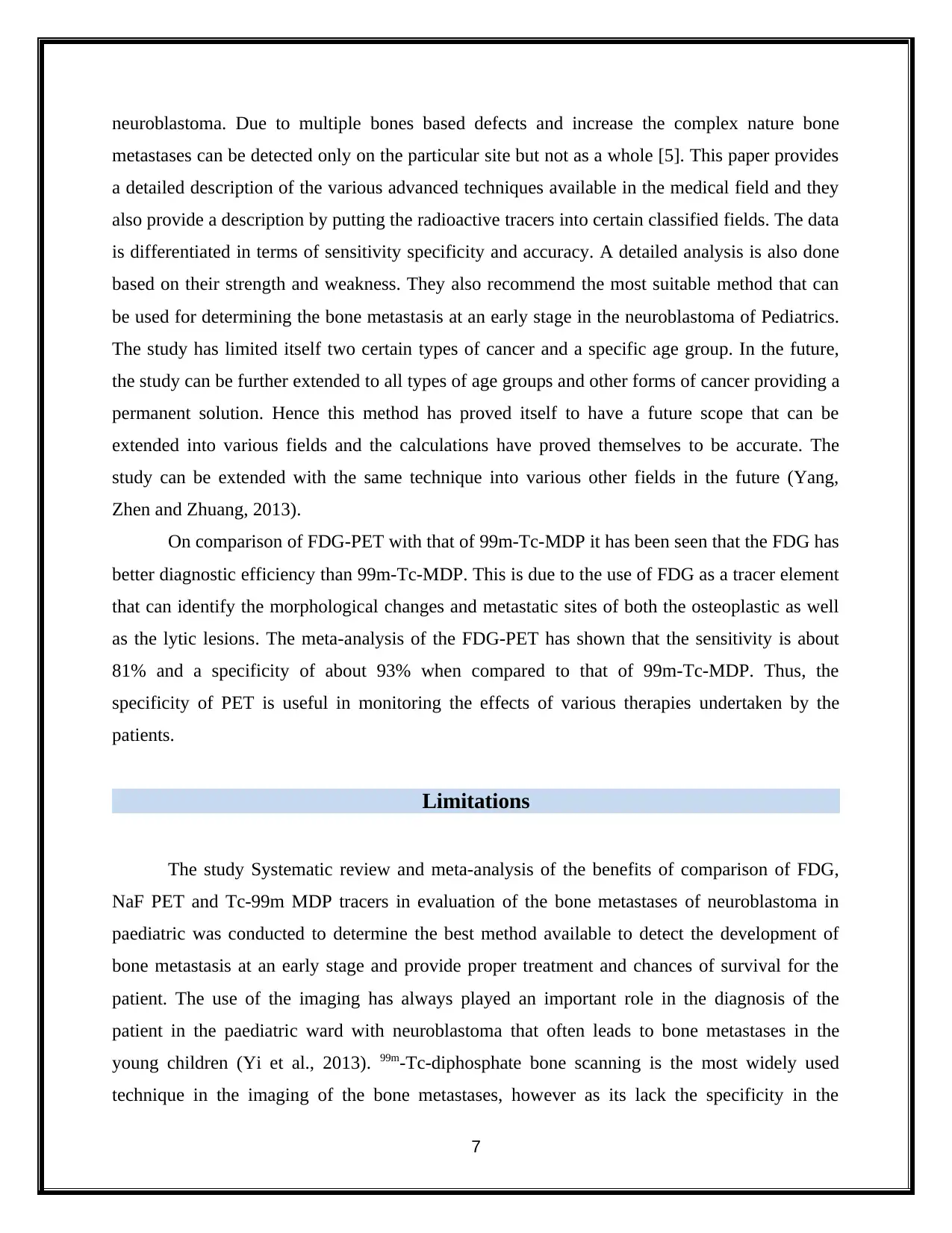
neuroblastoma. Due to multiple bones based defects and increase the complex nature bone
metastases can be detected only on the particular site but not as a whole [5]. This paper provides
a detailed description of the various advanced techniques available in the medical field and they
also provide a description by putting the radioactive tracers into certain classified fields. The data
is differentiated in terms of sensitivity specificity and accuracy. A detailed analysis is also done
based on their strength and weakness. They also recommend the most suitable method that can
be used for determining the bone metastasis at an early stage in the neuroblastoma of Pediatrics.
The study has limited itself two certain types of cancer and a specific age group. In the future,
the study can be further extended to all types of age groups and other forms of cancer providing a
permanent solution. Hence this method has proved itself to have a future scope that can be
extended into various fields and the calculations have proved themselves to be accurate. The
study can be extended with the same technique into various other fields in the future (Yang,
Zhen and Zhuang, 2013).
On comparison of FDG-PET with that of 99m-Tc-MDP it has been seen that the FDG has
better diagnostic efficiency than 99m-Tc-MDP. This is due to the use of FDG as a tracer element
that can identify the morphological changes and metastatic sites of both the osteoplastic as well
as the lytic lesions. The meta-analysis of the FDG-PET has shown that the sensitivity is about
81% and a specificity of about 93% when compared to that of 99m-Tc-MDP. Thus, the
specificity of PET is useful in monitoring the effects of various therapies undertaken by the
patients.
Limitations
The study Systematic review and meta-analysis of the benefits of comparison of FDG,
NaF PET and Tc-99m MDP tracers in evaluation of the bone metastases of neuroblastoma in
paediatric was conducted to determine the best method available to detect the development of
bone metastasis at an early stage and provide proper treatment and chances of survival for the
patient. The use of the imaging has always played an important role in the diagnosis of the
patient in the paediatric ward with neuroblastoma that often leads to bone metastases in the
young children (Yi et al., 2013). 99m-Tc-diphosphate bone scanning is the most widely used
technique in the imaging of the bone metastases, however as its lack the specificity in the
7
metastases can be detected only on the particular site but not as a whole [5]. This paper provides
a detailed description of the various advanced techniques available in the medical field and they
also provide a description by putting the radioactive tracers into certain classified fields. The data
is differentiated in terms of sensitivity specificity and accuracy. A detailed analysis is also done
based on their strength and weakness. They also recommend the most suitable method that can
be used for determining the bone metastasis at an early stage in the neuroblastoma of Pediatrics.
The study has limited itself two certain types of cancer and a specific age group. In the future,
the study can be further extended to all types of age groups and other forms of cancer providing a
permanent solution. Hence this method has proved itself to have a future scope that can be
extended into various fields and the calculations have proved themselves to be accurate. The
study can be extended with the same technique into various other fields in the future (Yang,
Zhen and Zhuang, 2013).
On comparison of FDG-PET with that of 99m-Tc-MDP it has been seen that the FDG has
better diagnostic efficiency than 99m-Tc-MDP. This is due to the use of FDG as a tracer element
that can identify the morphological changes and metastatic sites of both the osteoplastic as well
as the lytic lesions. The meta-analysis of the FDG-PET has shown that the sensitivity is about
81% and a specificity of about 93% when compared to that of 99m-Tc-MDP. Thus, the
specificity of PET is useful in monitoring the effects of various therapies undertaken by the
patients.
Limitations
The study Systematic review and meta-analysis of the benefits of comparison of FDG,
NaF PET and Tc-99m MDP tracers in evaluation of the bone metastases of neuroblastoma in
paediatric was conducted to determine the best method available to detect the development of
bone metastasis at an early stage and provide proper treatment and chances of survival for the
patient. The use of the imaging has always played an important role in the diagnosis of the
patient in the paediatric ward with neuroblastoma that often leads to bone metastases in the
young children (Yi et al., 2013). 99m-Tc-diphosphate bone scanning is the most widely used
technique in the imaging of the bone metastases, however as its lack the specificity in the
7
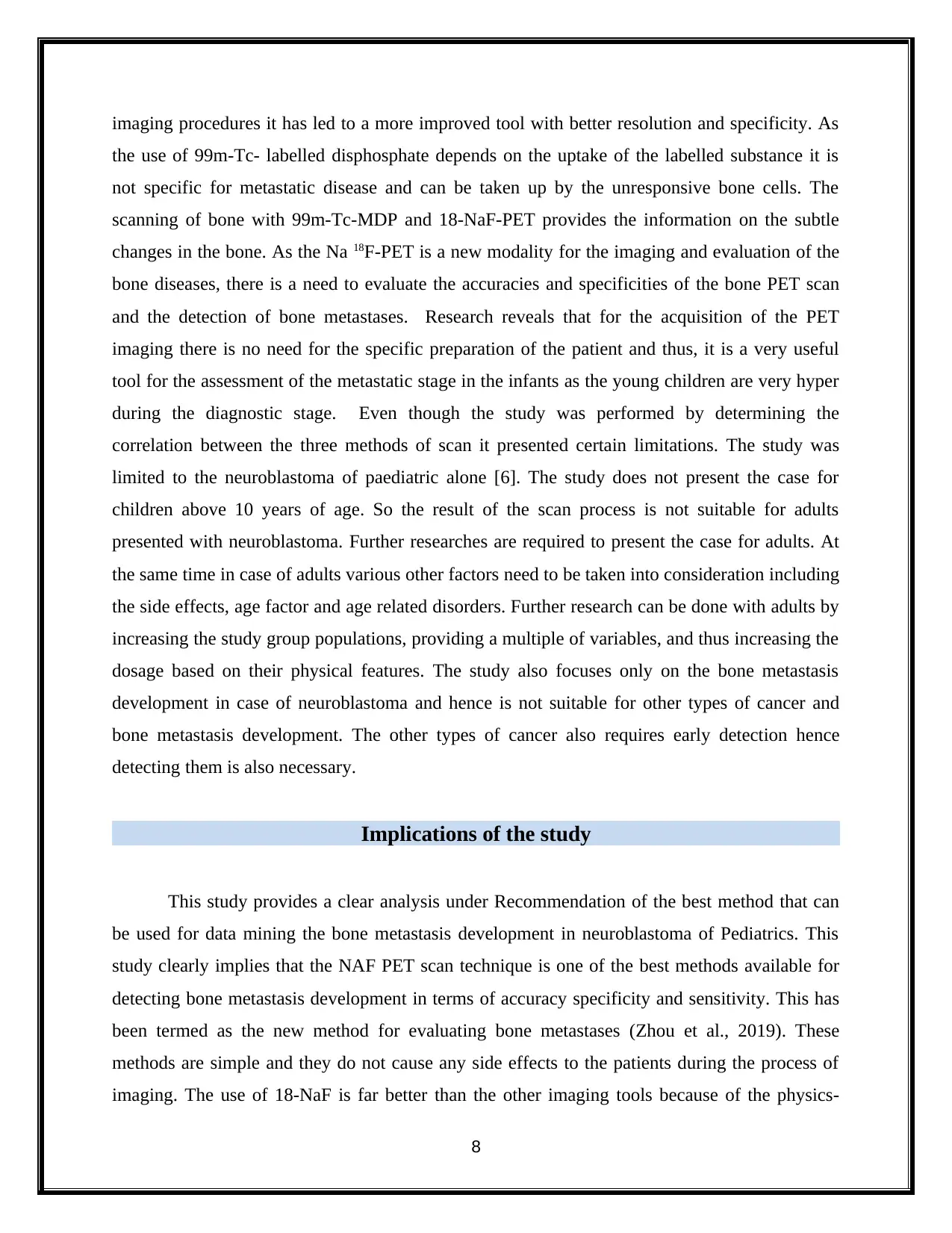
imaging procedures it has led to a more improved tool with better resolution and specificity. As
the use of 99m-Tc- labelled disphosphate depends on the uptake of the labelled substance it is
not specific for metastatic disease and can be taken up by the unresponsive bone cells. The
scanning of bone with 99m-Tc-MDP and 18-NaF-PET provides the information on the subtle
changes in the bone. As the Na 18F-PET is a new modality for the imaging and evaluation of the
bone diseases, there is a need to evaluate the accuracies and specificities of the bone PET scan
and the detection of bone metastases. Research reveals that for the acquisition of the PET
imaging there is no need for the specific preparation of the patient and thus, it is a very useful
tool for the assessment of the metastatic stage in the infants as the young children are very hyper
during the diagnostic stage. Even though the study was performed by determining the
correlation between the three methods of scan it presented certain limitations. The study was
limited to the neuroblastoma of paediatric alone [6]. The study does not present the case for
children above 10 years of age. So the result of the scan process is not suitable for adults
presented with neuroblastoma. Further researches are required to present the case for adults. At
the same time in case of adults various other factors need to be taken into consideration including
the side effects, age factor and age related disorders. Further research can be done with adults by
increasing the study group populations, providing a multiple of variables, and thus increasing the
dosage based on their physical features. The study also focuses only on the bone metastasis
development in case of neuroblastoma and hence is not suitable for other types of cancer and
bone metastasis development. The other types of cancer also requires early detection hence
detecting them is also necessary.
Implications of the study
This study provides a clear analysis under Recommendation of the best method that can
be used for data mining the bone metastasis development in neuroblastoma of Pediatrics. This
study clearly implies that the NAF PET scan technique is one of the best methods available for
detecting bone metastasis development in terms of accuracy specificity and sensitivity. This has
been termed as the new method for evaluating bone metastases (Zhou et al., 2019). These
methods are simple and they do not cause any side effects to the patients during the process of
imaging. The use of 18-NaF is far better than the other imaging tools because of the physics-
8
the use of 99m-Tc- labelled disphosphate depends on the uptake of the labelled substance it is
not specific for metastatic disease and can be taken up by the unresponsive bone cells. The
scanning of bone with 99m-Tc-MDP and 18-NaF-PET provides the information on the subtle
changes in the bone. As the Na 18F-PET is a new modality for the imaging and evaluation of the
bone diseases, there is a need to evaluate the accuracies and specificities of the bone PET scan
and the detection of bone metastases. Research reveals that for the acquisition of the PET
imaging there is no need for the specific preparation of the patient and thus, it is a very useful
tool for the assessment of the metastatic stage in the infants as the young children are very hyper
during the diagnostic stage. Even though the study was performed by determining the
correlation between the three methods of scan it presented certain limitations. The study was
limited to the neuroblastoma of paediatric alone [6]. The study does not present the case for
children above 10 years of age. So the result of the scan process is not suitable for adults
presented with neuroblastoma. Further researches are required to present the case for adults. At
the same time in case of adults various other factors need to be taken into consideration including
the side effects, age factor and age related disorders. Further research can be done with adults by
increasing the study group populations, providing a multiple of variables, and thus increasing the
dosage based on their physical features. The study also focuses only on the bone metastasis
development in case of neuroblastoma and hence is not suitable for other types of cancer and
bone metastasis development. The other types of cancer also requires early detection hence
detecting them is also necessary.
Implications of the study
This study provides a clear analysis under Recommendation of the best method that can
be used for data mining the bone metastasis development in neuroblastoma of Pediatrics. This
study clearly implies that the NAF PET scan technique is one of the best methods available for
detecting bone metastasis development in terms of accuracy specificity and sensitivity. This has
been termed as the new method for evaluating bone metastases (Zhou et al., 2019). These
methods are simple and they do not cause any side effects to the patients during the process of
imaging. The use of 18-NaF is far better than the other imaging tools because of the physics-
8
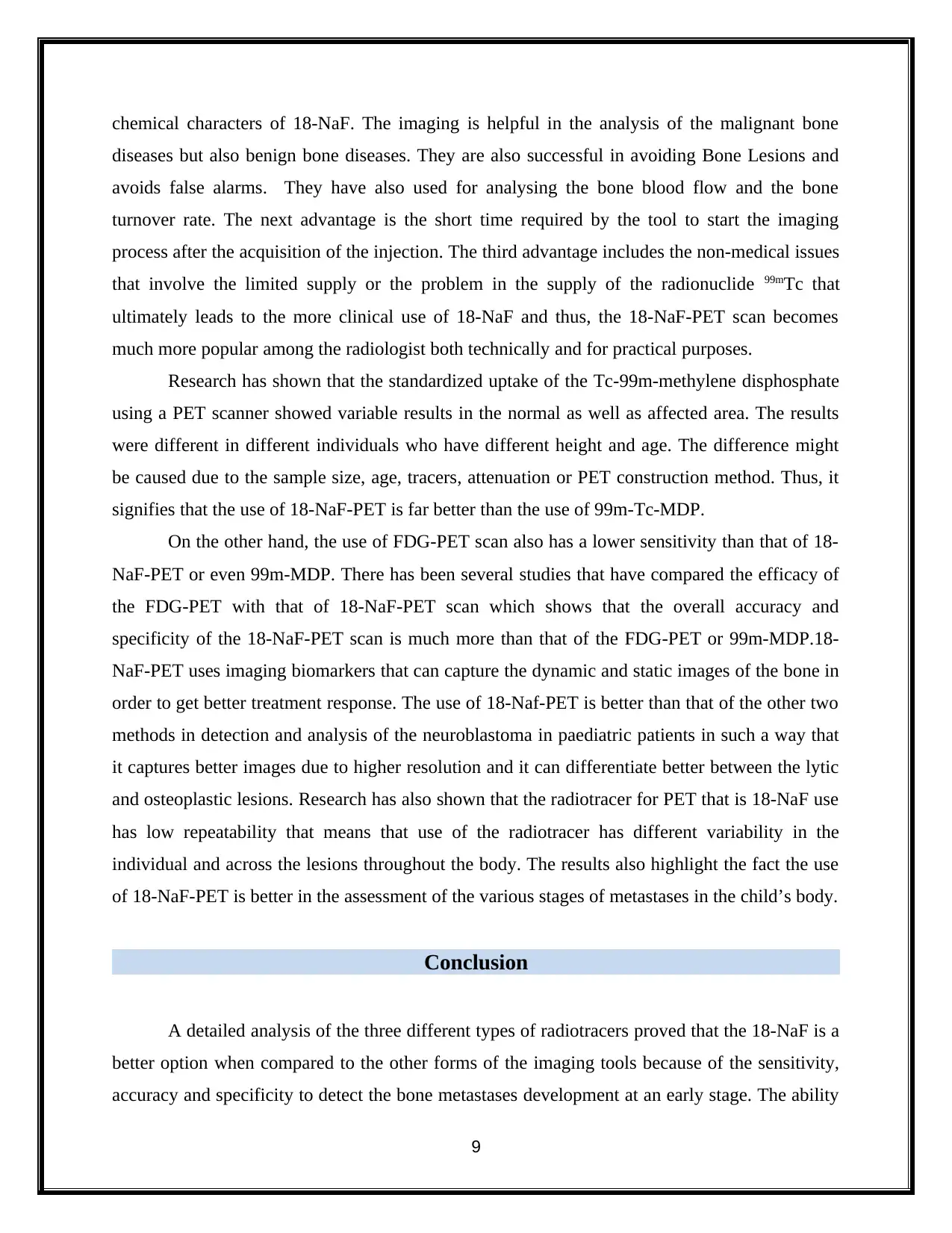
chemical characters of 18-NaF. The imaging is helpful in the analysis of the malignant bone
diseases but also benign bone diseases. They are also successful in avoiding Bone Lesions and
avoids false alarms. They have also used for analysing the bone blood flow and the bone
turnover rate. The next advantage is the short time required by the tool to start the imaging
process after the acquisition of the injection. The third advantage includes the non-medical issues
that involve the limited supply or the problem in the supply of the radionuclide 99mTc that
ultimately leads to the more clinical use of 18-NaF and thus, the 18-NaF-PET scan becomes
much more popular among the radiologist both technically and for practical purposes.
Research has shown that the standardized uptake of the Tc-99m-methylene disphosphate
using a PET scanner showed variable results in the normal as well as affected area. The results
were different in different individuals who have different height and age. The difference might
be caused due to the sample size, age, tracers, attenuation or PET construction method. Thus, it
signifies that the use of 18-NaF-PET is far better than the use of 99m-Tc-MDP.
On the other hand, the use of FDG-PET scan also has a lower sensitivity than that of 18-
NaF-PET or even 99m-MDP. There has been several studies that have compared the efficacy of
the FDG-PET with that of 18-NaF-PET scan which shows that the overall accuracy and
specificity of the 18-NaF-PET scan is much more than that of the FDG-PET or 99m-MDP.18-
NaF-PET uses imaging biomarkers that can capture the dynamic and static images of the bone in
order to get better treatment response. The use of 18-Naf-PET is better than that of the other two
methods in detection and analysis of the neuroblastoma in paediatric patients in such a way that
it captures better images due to higher resolution and it can differentiate better between the lytic
and osteoplastic lesions. Research has also shown that the radiotracer for PET that is 18-NaF use
has low repeatability that means that use of the radiotracer has different variability in the
individual and across the lesions throughout the body. The results also highlight the fact the use
of 18-NaF-PET is better in the assessment of the various stages of metastases in the child’s body.
Conclusion
A detailed analysis of the three different types of radiotracers proved that the 18-NaF is a
better option when compared to the other forms of the imaging tools because of the sensitivity,
accuracy and specificity to detect the bone metastases development at an early stage. The ability
9
diseases but also benign bone diseases. They are also successful in avoiding Bone Lesions and
avoids false alarms. They have also used for analysing the bone blood flow and the bone
turnover rate. The next advantage is the short time required by the tool to start the imaging
process after the acquisition of the injection. The third advantage includes the non-medical issues
that involve the limited supply or the problem in the supply of the radionuclide 99mTc that
ultimately leads to the more clinical use of 18-NaF and thus, the 18-NaF-PET scan becomes
much more popular among the radiologist both technically and for practical purposes.
Research has shown that the standardized uptake of the Tc-99m-methylene disphosphate
using a PET scanner showed variable results in the normal as well as affected area. The results
were different in different individuals who have different height and age. The difference might
be caused due to the sample size, age, tracers, attenuation or PET construction method. Thus, it
signifies that the use of 18-NaF-PET is far better than the use of 99m-Tc-MDP.
On the other hand, the use of FDG-PET scan also has a lower sensitivity than that of 18-
NaF-PET or even 99m-MDP. There has been several studies that have compared the efficacy of
the FDG-PET with that of 18-NaF-PET scan which shows that the overall accuracy and
specificity of the 18-NaF-PET scan is much more than that of the FDG-PET or 99m-MDP.18-
NaF-PET uses imaging biomarkers that can capture the dynamic and static images of the bone in
order to get better treatment response. The use of 18-Naf-PET is better than that of the other two
methods in detection and analysis of the neuroblastoma in paediatric patients in such a way that
it captures better images due to higher resolution and it can differentiate better between the lytic
and osteoplastic lesions. Research has also shown that the radiotracer for PET that is 18-NaF use
has low repeatability that means that use of the radiotracer has different variability in the
individual and across the lesions throughout the body. The results also highlight the fact the use
of 18-NaF-PET is better in the assessment of the various stages of metastases in the child’s body.
Conclusion
A detailed analysis of the three different types of radiotracers proved that the 18-NaF is a
better option when compared to the other forms of the imaging tools because of the sensitivity,
accuracy and specificity to detect the bone metastases development at an early stage. The ability
9
Secure Best Marks with AI Grader
Need help grading? Try our AI Grader for instant feedback on your assignments.

to have a practical usage of this 18-NaF imaging techniques also plays a major role in
determining this project as the best option available. The correlation factors were calculated for
all the three images and the final output proved that the 18-NaF imaging technique is the most
suitable option available.
10
determining this project as the best option available. The correlation factors were calculated for
all the three images and the final output proved that the 18-NaF imaging technique is the most
suitable option available.
10
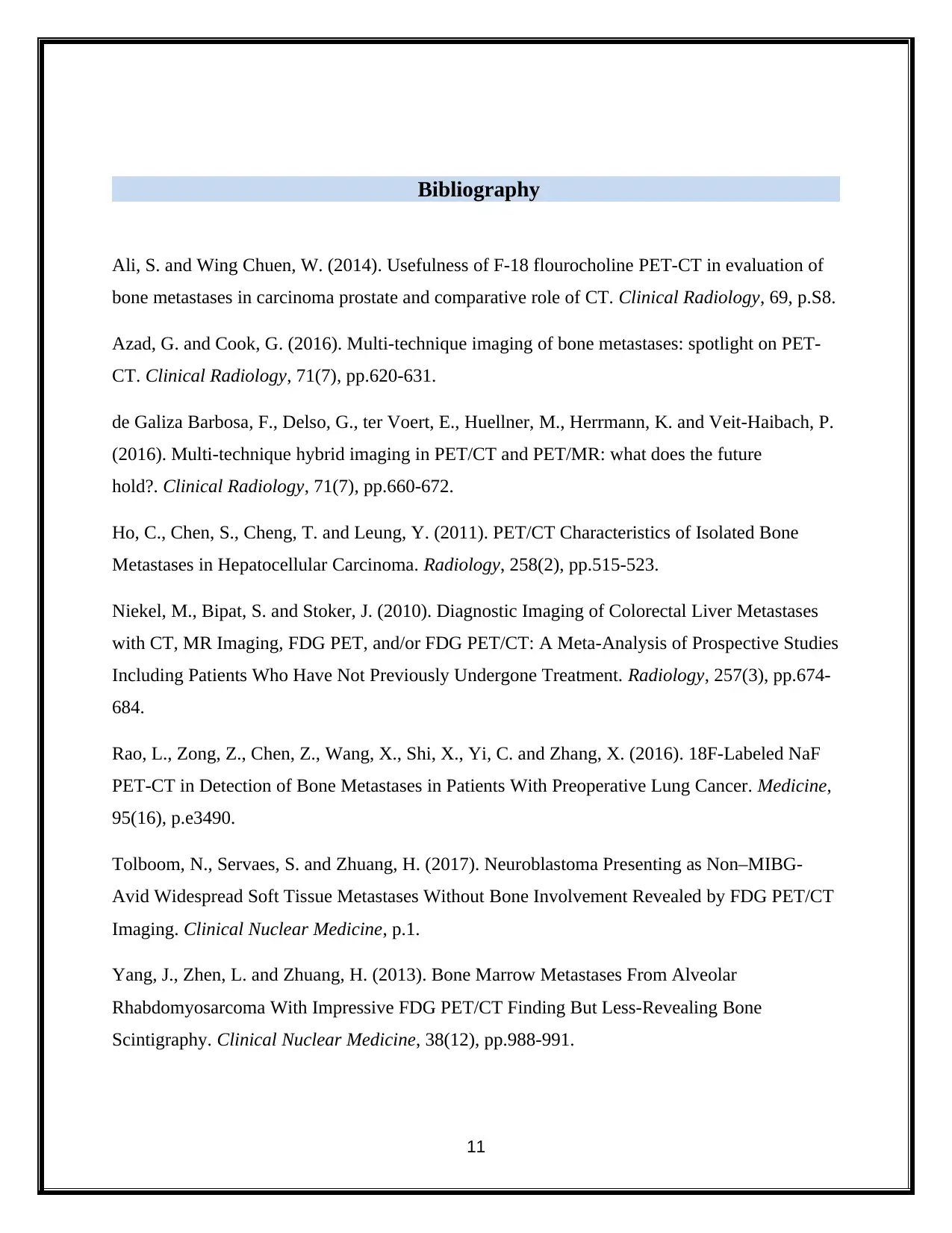
Bibliography
Ali, S. and Wing Chuen, W. (2014). Usefulness of F-18 flourocholine PET-CT in evaluation of
bone metastases in carcinoma prostate and comparative role of CT. Clinical Radiology, 69, p.S8.
Azad, G. and Cook, G. (2016). Multi-technique imaging of bone metastases: spotlight on PET-
CT. Clinical Radiology, 71(7), pp.620-631.
de Galiza Barbosa, F., Delso, G., ter Voert, E., Huellner, M., Herrmann, K. and Veit-Haibach, P.
(2016). Multi-technique hybrid imaging in PET/CT and PET/MR: what does the future
hold?. Clinical Radiology, 71(7), pp.660-672.
Ho, C., Chen, S., Cheng, T. and Leung, Y. (2011). PET/CT Characteristics of Isolated Bone
Metastases in Hepatocellular Carcinoma. Radiology, 258(2), pp.515-523.
Niekel, M., Bipat, S. and Stoker, J. (2010). Diagnostic Imaging of Colorectal Liver Metastases
with CT, MR Imaging, FDG PET, and/or FDG PET/CT: A Meta-Analysis of Prospective Studies
Including Patients Who Have Not Previously Undergone Treatment. Radiology, 257(3), pp.674-
684.
Rao, L., Zong, Z., Chen, Z., Wang, X., Shi, X., Yi, C. and Zhang, X. (2016). 18F-Labeled NaF
PET-CT in Detection of Bone Metastases in Patients With Preoperative Lung Cancer. Medicine,
95(16), p.e3490.
Tolboom, N., Servaes, S. and Zhuang, H. (2017). Neuroblastoma Presenting as Non–MIBG-
Avid Widespread Soft Tissue Metastases Without Bone Involvement Revealed by FDG PET/CT
Imaging. Clinical Nuclear Medicine, p.1.
Yang, J., Zhen, L. and Zhuang, H. (2013). Bone Marrow Metastases From Alveolar
Rhabdomyosarcoma With Impressive FDG PET/CT Finding But Less-Revealing Bone
Scintigraphy. Clinical Nuclear Medicine, 38(12), pp.988-991.
11
Ali, S. and Wing Chuen, W. (2014). Usefulness of F-18 flourocholine PET-CT in evaluation of
bone metastases in carcinoma prostate and comparative role of CT. Clinical Radiology, 69, p.S8.
Azad, G. and Cook, G. (2016). Multi-technique imaging of bone metastases: spotlight on PET-
CT. Clinical Radiology, 71(7), pp.620-631.
de Galiza Barbosa, F., Delso, G., ter Voert, E., Huellner, M., Herrmann, K. and Veit-Haibach, P.
(2016). Multi-technique hybrid imaging in PET/CT and PET/MR: what does the future
hold?. Clinical Radiology, 71(7), pp.660-672.
Ho, C., Chen, S., Cheng, T. and Leung, Y. (2011). PET/CT Characteristics of Isolated Bone
Metastases in Hepatocellular Carcinoma. Radiology, 258(2), pp.515-523.
Niekel, M., Bipat, S. and Stoker, J. (2010). Diagnostic Imaging of Colorectal Liver Metastases
with CT, MR Imaging, FDG PET, and/or FDG PET/CT: A Meta-Analysis of Prospective Studies
Including Patients Who Have Not Previously Undergone Treatment. Radiology, 257(3), pp.674-
684.
Rao, L., Zong, Z., Chen, Z., Wang, X., Shi, X., Yi, C. and Zhang, X. (2016). 18F-Labeled NaF
PET-CT in Detection of Bone Metastases in Patients With Preoperative Lung Cancer. Medicine,
95(16), p.e3490.
Tolboom, N., Servaes, S. and Zhuang, H. (2017). Neuroblastoma Presenting as Non–MIBG-
Avid Widespread Soft Tissue Metastases Without Bone Involvement Revealed by FDG PET/CT
Imaging. Clinical Nuclear Medicine, p.1.
Yang, J., Zhen, L. and Zhuang, H. (2013). Bone Marrow Metastases From Alveolar
Rhabdomyosarcoma With Impressive FDG PET/CT Finding But Less-Revealing Bone
Scintigraphy. Clinical Nuclear Medicine, 38(12), pp.988-991.
11

Yi, X., Fan, M., Liu, Y., Zhang, H. and Liu, S. (2013). 18FDG PET and PET-CT for the
detection of bone metastases in patients with head and neck cancer. A meta-analysis. Journal of
Medical Imaging and Radiation Oncology, 57(6), pp.674-679.
Zhou, J., Gou, Z., Wu, R., Yuan, Y., Yu, G. and Zhao, Y. (2019). Comparison of
PSMA-PET/CT, choline-PET/CT, NaF-PET/CT, MRI, and bone scintigraphy in the diagnosis of
bone metastases in patients with prostate cancer: a systematic review and meta-analysis. Skeletal
Radiology.
12
detection of bone metastases in patients with head and neck cancer. A meta-analysis. Journal of
Medical Imaging and Radiation Oncology, 57(6), pp.674-679.
Zhou, J., Gou, Z., Wu, R., Yuan, Y., Yu, G. and Zhao, Y. (2019). Comparison of
PSMA-PET/CT, choline-PET/CT, NaF-PET/CT, MRI, and bone scintigraphy in the diagnosis of
bone metastases in patients with prostate cancer: a systematic review and meta-analysis. Skeletal
Radiology.
12
1 out of 13
Related Documents
Your All-in-One AI-Powered Toolkit for Academic Success.
+13062052269
info@desklib.com
Available 24*7 on WhatsApp / Email
![[object Object]](/_next/static/media/star-bottom.7253800d.svg)
Unlock your academic potential
© 2024 | Zucol Services PVT LTD | All rights reserved.




